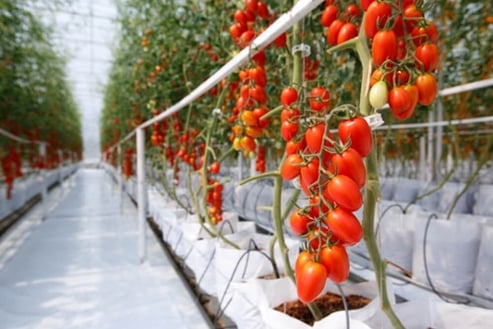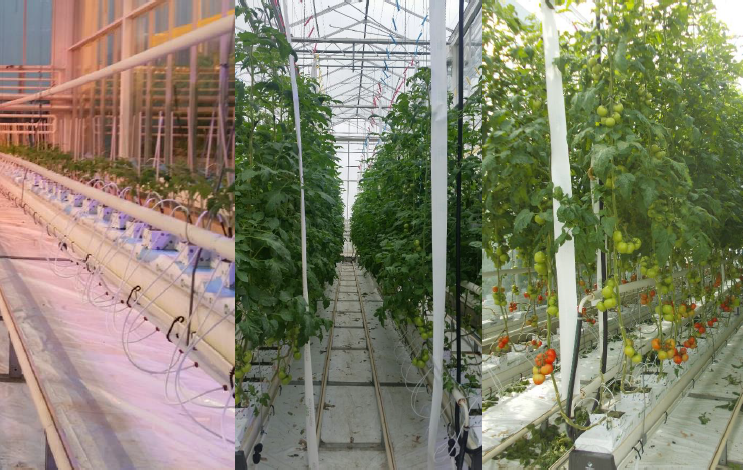A look at the latest technologies being used in 2022 to improve yield and crop quality in greenhouse tomatoes
New greenhouse technologies and recent advances in horticulture are continuing to transform food production around the world. Greenhouse tomato growers are investing in several emerging horticulture technologies to achieve unprecedented yield and fruit quality.
Demand for fresh greenhouse tomatoes remains strong because of their consistent high quality. To further increase sales, some growers have expanded their selections to include heirloom, grape, and cocktail varieties. ‘Cluster tomatoes’ continue to be very popular as well. True to their name, these tomatoes are harvested in clusters attached to the vine, providing an aesthetic appeal along with optimum freshness and taste.
The challenges faced by greenhouse tomato growers have evolved to some extent. Overall power and heat requirements, especially in northern climates, remain a concern, but power usage has greatly decreased with the advent of LED technology.
Pathogens are another ongoing greenhouse management concern. The transpiration of large greenhouse tomato plants causes high humidity within the structure that supports the growth of diseases caused by various fungi, bacteria, and viruses. The greenhouse recirculating water system can also harbor various diseases. Some current greenhouse tomato diseases include water molds, bacterial spot, bacterial wilt, bacterial canker, Botrytis gray mold, Pythium stem rot and target spot.
Fortunately, innovative greenhouse technologies are helping growers address these ongoing challenges, with some solutions simultaneously addressing multiple pain points.

Artificial Intelligence Horticulture Technology
Several companies now offer advanced greenhouse management systems that approach, or can truly be considered, artificial intelligence (AI). They are able to analyze large amounts of real-time sensor data on temperature, humidity, light spectrum, light intensity, water quality and more. Using this analysis, the AI automatically adjusts light spectrum, intensity or angle, vents, curtains, and other greenhouse components to achieve the best possible crop performance. Therefore, in addition to achieving higher quality and higher yields, growers using these systems also benefit from small savings in energy use.
Over time, an AI system can also be harnessed to predict crop needs in its specific greenhouse, using the huge amounts of data captured and analyzed over time. In addition, these advanced software systems allow labor to be better directed and therefore more efficient.
Advanced Greenhouse Technology: Robotic Tomato Harvest
To address worsening labor concerns, many technology providers have recently launched robotic harvesters for greenhouse crops and many more are close to commercialization.
Since 2020, AppHarvest has operated its robotic crop management and harvest system at its location in Kentucky, where 700,000 plants produce up to 45 million pounds of tomatoes per year. The robots move from row to row, using machine vision to assess which tomatoes are ripe enough to be harvested. The snipping arm harvests accordingly into a bin that’s automatically transported to a central location for packaging.
Nanobubbles: Sustainable, Chemical-Free Horticultural Science and Technology
With new policies around sustainability and the importance of combatting climate change, tomato growers are looking for emerging AgTech to reduce reliance on pesticides and other chemicals, improve irrigation water use efficiency and increase crop production. Nanobubble technology is a sustainable, chemical-free method to enhance irrigation water naturally.
Technology that injects nanobubbles into irrigation water is a superior water improvement method that prevents and reduces pathogens such as Phytophthora and Pythium and removes biofilm and mineral build-up to improve irrigation system hygiene. The supersaturation of dissolved oxygen in the irrigation water enhances oxygen availability and nutrient transport at the root zone and the unique properties of nanobubbles contribute to improved yield and harvest quality.
Nanobubbles are less than 200nm in diameter and possess properties that allow them to oxygenate all parts of the water system, while delivering other benefits. Moleaer’s nanobubble generators, now being used in over 500 greenhouses worldwide, inject two forms of oxygen: dissolved oxygen (DO) and oxygen-containing nanobubbles.

In greenhouse tomato trials at the vegetable production research station ‘Sint-Katelijne-Waver’ in Belgium, Moleaer technology achieved sustained DO levels of 25 mg/l and a 10 percent increase in tomato production. Over the two-month harvesting period, plants that received nanobubble-infused water produced an average yield of 13.2kg/m² compared to 12.0 kg/m² produced by plants that received water oxygenated using a traditional method (DO 9 mg/l).
Aided Pollination to Increase Crop Yield Indoors
Tomato plants must be self-pollinated, and the limited air movement and high humidity poses extra challenges for the fertilization of greenhouse tomato plants. Many growers purchase hives of bumble bees to pollinate, or their employees use devices which blow or vibrate flower clusters once or more per day to release sufficient pollen for pollination.
A new automated system uses AI to identify tomato flowers ready for pollination, then sends air pulses that vibrate the flowers to mimic the ‘buzz’ pollination naturally performed by bumblebees.
As the world’s population grows, demand for fresh tomatoes will continue to increase. It’s up to greenhouse growers to understand how innovative AgTech technologies can prevent disease and ensure high yields and high-quality fruit through super-high root oxygenation and other aspects of production that support plant health and vigorous growth.


